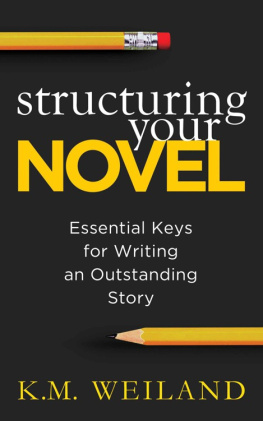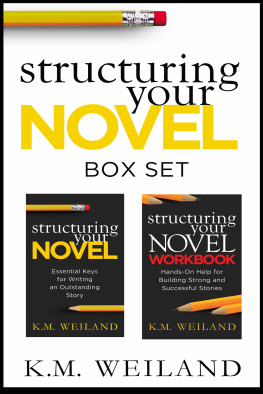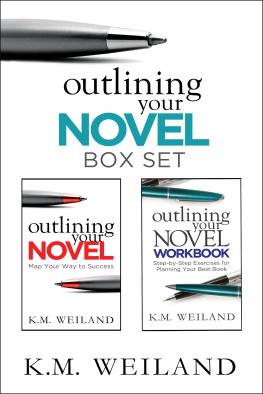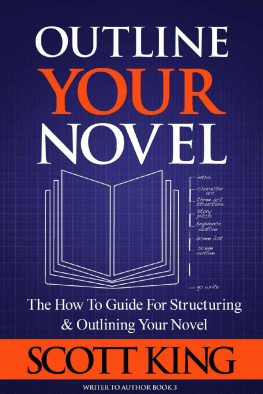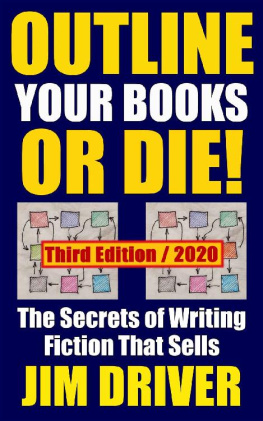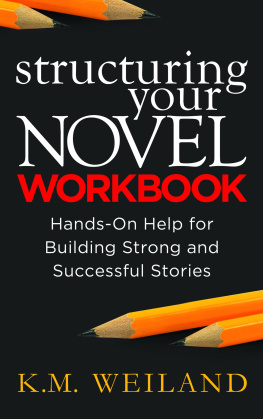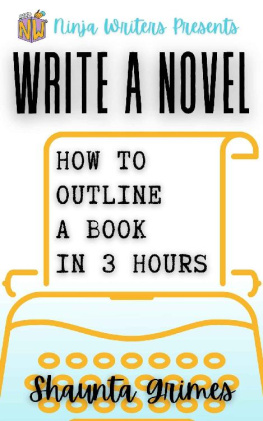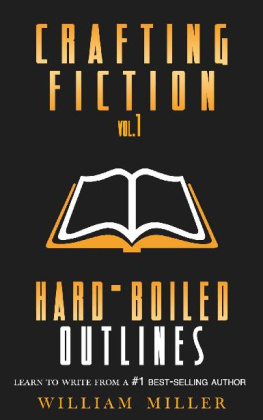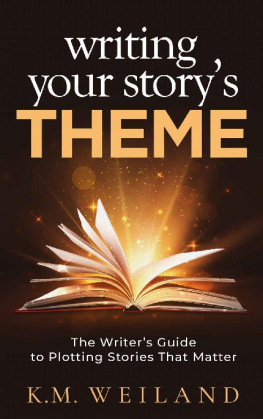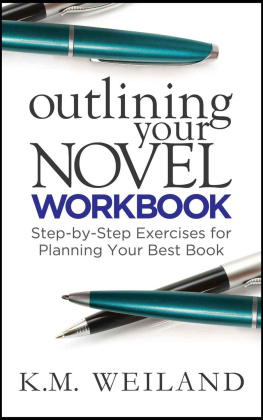Outlining Your Novel:
Map Your Way to Success
K.M. Weiland
PenForASword Publishing
Outlining Your Novel: Map Your Way to Success Copyright 2011
K.M. Weiland
All rights reserved. No part of this publication may be reproduced, stored in a retrieval system, or transmitted in any form or by any means electronic, mechanical, photocopying, recording, or otherwise without the prior written permission of the publisher and copyright owner.
Published by PenForASword Publishing
Dedicated to my beloved Savior,
who outlines my life much better
than I do those of my characters.
And to my mother,
who reads every post,
watches every video,
and encourages me every day.
K.M. Weiland lives in make-believe worlds, talks to imaginary friends, and survives primarily on chocolate truffles and espresso. She is the author of the historical western A Man Called Outlaw , the medieval epic Behold the Dawn , and the fantasy Dreamlander , as well as Structuring Your Novel: Essential Keys for Writing an Outstanding Story . When shes not making things up, shes busy mentoring other authors through her blog http://www.helpingwritersbecomeauthors.com . She makes her home in western Nebraska. Visit her on her website ( http://www.kmweiland.com ), Facebook , or Twitter to participate in her Writing Question of the Day (#WQOTD). You can email her at km.weiland@ymail.com.
Table of Contents
Introduction
Chapter One: Should You Outline?
Chapter Two: Before You Begin Your Outline
Chapter Three: Crafting Your Premise
Chapter Four: General Sketches, Pt. 1: Connecting the Dots
Chapter Five: General Sketches, Pt. 2: Key Story Factors
Chapter Six: Character Sketches, Pt. 1: Exploring Backstory
Chapter Seven: Character Sketches, Pt. 2: Character Interviews
Chapter Eight: Discovering Your Setting
Chapter Nine: The Extended Outline: Creating a Story
Chapter Ten: The Abbreviated Outline: Drawing Your Road Map
Chapter Eleven: Conclusion: Using Your Outline
Endnotes
Acknowledgements
As always, Im indebted to the many people who prompted, encouraged, critiqued, and assisted me throughout the writing of this book. In no particular order, those people are:
My sister Amy: #1 fan, cheerleader extraordinaire, and sharer of chocolate.
The most fantabulous beta readers on the planet: Adrie Ashford, Daniel Farnum, Lorna G. Poston, Braden Russell, Janalyn Voigt, and Linda Yezak.
My everlastingly supportive, encouraging, and opinionated family: Ted, Linda, Derek, and Jared.
My author interviewees, ten of the wisest and most generous authors I know, all of whom consented to share their experiences in the pages of this book: Larry Brooks, Elizabeth Spann Craig, Lisa Grace, Dan L. Hays, Jody Hedlund, Carolyn Kaufman, Becky Levine, Roz Morris, John Robinson, and Aggie Villanueva.
Wordplayers everywhere: Huge shout out to the readers of my blog Wordplay, listeners of my podcast, and watchers of my vlog. You guys are why I do what I do. This book is for you!
Introduction
T he art of fiction is a wide-open sea of possibilities, in which the author is a wave-tossed ship along for the ride. And what a glorious ride it is! On the other hand, the craft of fiction puts that same ship under the expert guidance of a captain who knows how to decipher his map of those seas and then furl, trim, and jib his sails so his ship will carry him through the story on precisely the right course. Craft is all about organization, and thats where the outlinethe mapbecomes so important.
Through my writing blog and editing services, Ive been fortunate to connect with and mentor thousands of writers. One of the topics Im frequently asked about is outlining. How do I do it? Why do I do it? Is it worth the time and effort? My answer to the latter question is always an emphatic yes. Outlining has transformed my own writing process from hit-and-miss creativity to a reliable process of story craft. Outlining allows me to ride the waves of my story with utter confidence, channeling the art into the craft to produce solid stories. And the best part about outlining? Its entirely learnable.
In the following pages, youll find an in-depth exploration of the process Ive designed for my own writing. Well take a look at the benefits of outlining and dispel some of the common misconceptions that make writers balk at the idea of outlining. Well discover what type of outline best suits your personality, lifestyle, and writing preferences. Then well dive into the step-by-step process of building your outline (and, as a result, your story) from the premise up.
Because the methodology of outlining is as much about the methodology of storytelling as it is organizing your notes, well cover such important elements of the craft as character, setting, structure, conflict, and theme. Youll learn how to define the kind of story you want to write and how to identify and write to your specific audience. Youll also find bonus interviews with respected novelists and memoirists, who offer invaluable insights into their outlining experiences.
What you discover in the pages ahead may strengthen and expand the outlining methods youre already using, or it may transform your writing process altogether. My goal in compiling this book was to create a manual that would guide you through the basics of constructing an outline and inspire you to use this invaluable tool to take your stories to the next level.
Happy writing!
K.M. Weiland
October 2011
Chapter One
Should You Outline?
In preparing for battle, I have always found that plans are useless, but planning is indispensable.
Dwight D. Eisenhower
G enerally speaking, writers fall into two different categories: outliners and non-outliners (or, as some writers prefer it, plotters and pantsers). I say categories, but armies might be a better word, since these two camps of the writing world can often be found waging passionate war for their chosen methodology. Perhaps youve encountered or even participated in a conversation like the following exchange:
Ollie Outliner: Im lost without my outline. Gotta have a road map, so I know where Im going. It makes the journey so much easier. How can anyone write a coherent story without some idea of whats supposed to happen? Think how much time you waste writing dead-end scenes and meandering subplots!
Polly Pantser: Where do you get the patienceand the timeto spend weeks, or even months, outlining a story? Id go crazy if I had to wait that long to start writing. Besides, I lose all the sense of adventure if I know how the story is going to turn out before I start writing it.
Without question, both sides present good arguments. But how do you know which is telling the truth? Hold onto your britcheshere comes the shocker.
They both are.
Writinglike all of artoffers few absolutes. If it did, it would quickly stultify into set patterns and tiny boxes of preconceived ideas and methods. This is nowhere more evident than in the writing process itself. Its like a deck of cards, and every writer shuffles it a little differently. Just as our stories are (we hope) distinctive, so are our personalities and lifestylesand, as a result, our working patterns. In pursuit of bettering our craft, we voraciously study the masters by reading every how-to book and author interview we can get our hands on. But what we sometimes dont realize is, even if a particular method or routine works for one author, that singular success doesnt make it a universal principle.
In general, human beings like the protective solidity of rules. We like the assurance that if we write one page every day, five days a week, well finish a book in a year and be published in two. But life doesnt work that way. Writing a page a day
Next page

